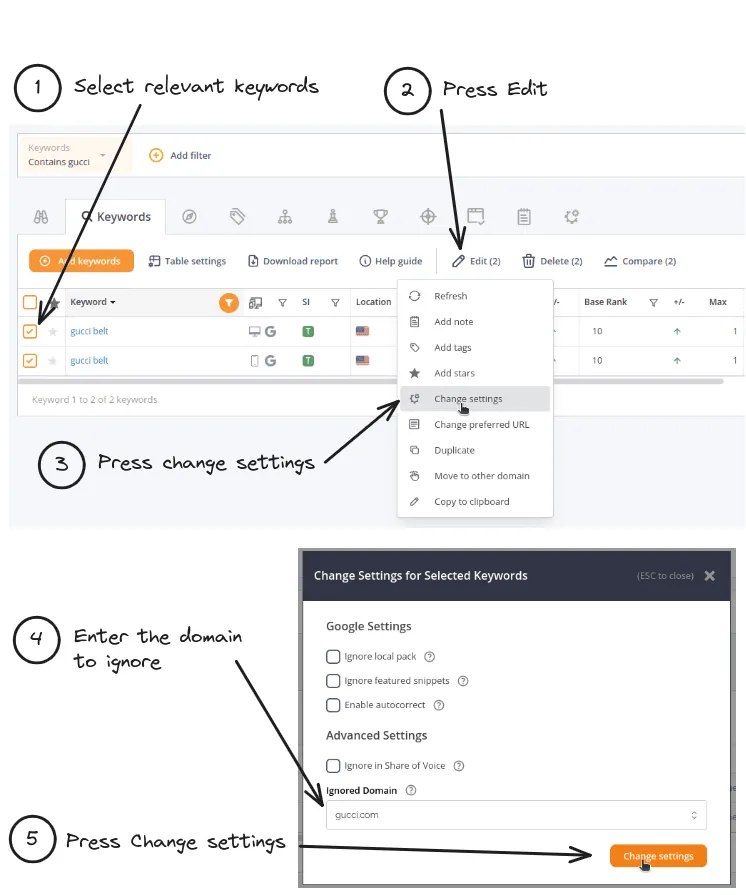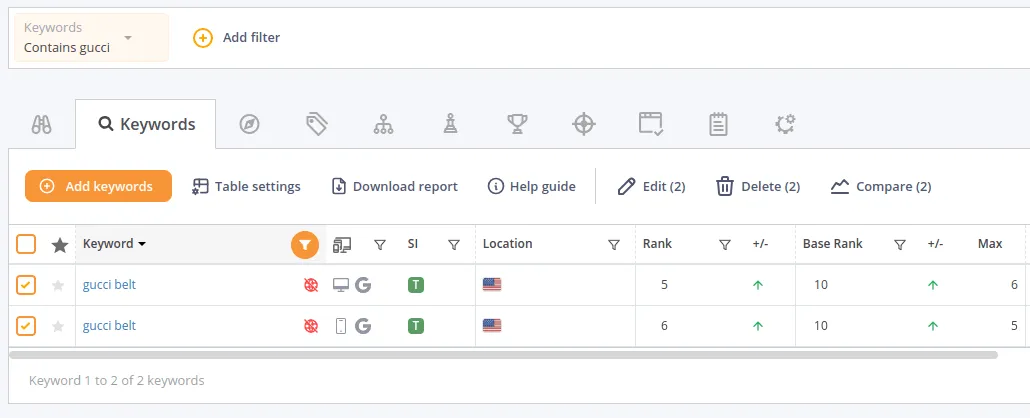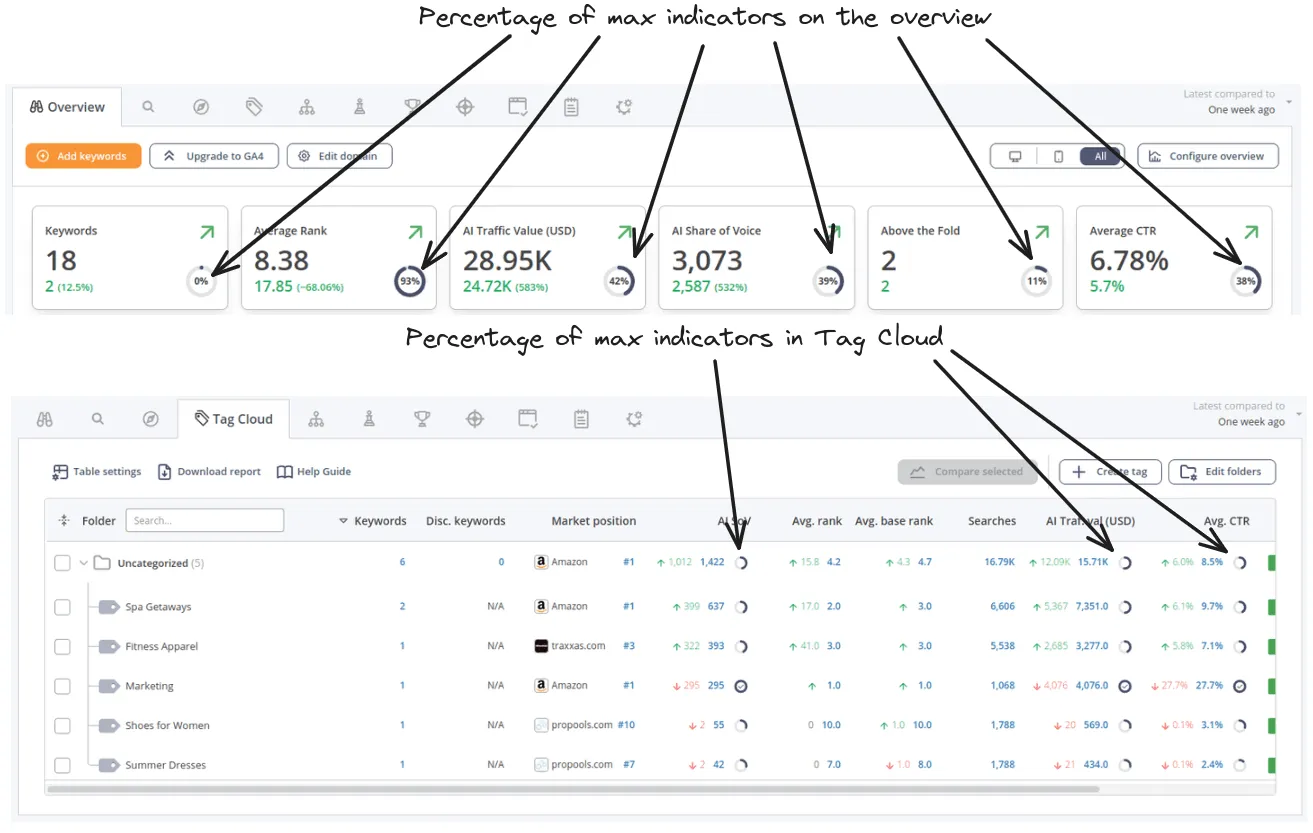Keyword settings, ignoring SERP elements and related metrics
KeywordsLearn how to customize the rules of your rankings!
In AccuRanker, you have the power to fine-tune your rankings by excluding specific results. This feature is particularly useful to ensure your rankings accurately represent your site's potential performance on the SERP.
In this guide, we will delve into the various elements you can choose to ignore and explore related concepts like "Max Rank" and "Base Rank."
Ignoring a Domain
Starting in October 2023, AccuRanker introduced the capability to disregard specific domains when determining your ranks. But why is this important? The primary aim is to provide a more realistic portrayal of your performance. For certain keywords, there are domains that you realistically can't expect to outperform.
Let's illustrate this with an example: Imagine you're running an e-commerce website and aiming to rank for the keyword "gucci belt." Since Google's Core update in August 2023, surpassing gucci.com for a branded keyword like this has been almost impossible. In such a scenario, you may want your rankings to reflect the highest position you can realistically achieve, given that gucci.com is virtually unbeatable.
To address this, you can opt to ignore the domain gucci.com for the specific keyword "gucci belt." As a result, your ranking will be recalibrated accordingly. In fact, you might want to do this for all keywords including the phrase “gucci” - this is possible by adding a keyword filter and bulk changing your keyword settings.
Even though you've excluded gucci.com, you'll still be able to see the "Original" rank in the “Base Rank” column on the keyword list. The Base Rank is the rank before ignoring anything on the SERP. You will also be able to see the “Max achievable base rank” in the max column next to “Base Rank”. The Max achievable rank is the first rank after the ignored domain. For instance, if gucci.com occupies the top three spots on the SERP for the keyword "gucci belt," your max rank becomes 4, indicating that the best position you can reach is the fourth spot on the SERP. However, if gucci.com occupies rank 1,2 and 4 we will only ignore rank 1 and 2, when calculating your rank, and the max rank will be 3.
Here is a short guide how to ignore a domain:

Now, after applying the settings, you will see the rank and max rank changes. In this example, gucci.com occupied the top 5 spots on desktop and top 4 spots on mobile. This makes the new max ranks 6 and 5. This also means that we will ignore 5 results on desktop and 4 on mobile, such that the rank has gone from 10 to 5 for desktop and 6 for mobile.

The updated max rank for this keyword will also determine for instance the Max AI Share of Voice, Max AI Traffic Value, which will be the AI Share of Voice and Traffic Value achieved if you reach the max rank. Learn more about this later in the guide.
Ignoring local results
Local results can play a significant role in search engine rankings, especially for businesses targeting a specific geographic area. However, in some cases, you may want to focus on the organic search results and ignore the local listings. AccuRanker provides you with the flexibility to do just that.
Ignoring local results is essential when you want to gauge your website's performance without the influence of location-specific listings. For instance, if you're running a national e-commerce website and wish to track your rankings for a product, you may want to disregard the local business listings that appear above the organic search results.
To ignore local results, apply the same steps as outlined in the section above “Ignoring a domain”.
Even though you've excluded local results, you'll still be able to see the "Original" rank in the “Base Rank” column on the keyword list. You will also be able to see the “Max achievable base rank” in the “Max” column next to “Base Rank”. The max rank is the first rank after the ignored local results. Whereas ignoring a domain will only ignore the domain if it occupies the top rank(s), applying ignore local results will ignore all local results on the SERP.
Ignoring featured snippets
Featured snippets are a part of many searches with informational search intent. They provide users with quick answers to their queries, often appearing at the top of the page. However, there are situations where you might want to exclude featured snippets from your ranking analysis.
Ignoring featured snippets is particularly valuable when you want to understand your website's performance in the traditional organic search results, excluding the impact of featured snippets.
To ignore featured snippets, apply the same steps as outlined in the section above “Ignoring a domain”.
Even though you've excluded featured snippets, you'll still be able to see the "Original" rank in the “Base Rank” column on the keyword list. You will also be able to see the “Max achievable base rank” in the “Max” column next to “Base Rank”. The max rank will typically be 2 (unless there are also ignored domains or ignored local results) and your rank will typically be adjusted by 1. It is possible to ignore your own domain, if you own the featured snippet yourself.
General rules of ignore settings
- Ignore settings will not affect past rankings, only present and future.
- Ignore settings will affect your rank and max rank, but never your base rank.
- It is possible to ignore results you own yourself (e.g. if you occupy a featured snippet, you can still ignore it)
- The max rank is the base rank of the first result on the SERP occupied by a result that you do not ignore.
What is Base Rank?
The base rank is the unaltered rank of a result on a SERP page before ignoring any elements on the SERP.
What is Max Rank?
Max Rank, in the context of AccuRanker, refers to the highest achievable position on the SERP for a specific keyword after removing excluded domains, local results, and/or featured snippets if these settings are applied. It represents the base rank of the first result on the SERP that is not ignored. It reflects the best rank you can achieve for a given keyword. If a keyword has the default settings the max rank will always be 1.
Max Rank helps define the other “Max values” in AccuRanker found on the Overview page, the Keyword List and the Tag Cloud. Learn more in the next section.
What is Max AI Share of Voice?
The Max AI Share of Voice is the Share of Voice corresponding to the Max Rank on the page. This metric can help gauge the potential of a keyword. The AI Share of Voice corresponds to the dynamic CTR (based on AccuRankers AI model) for a given result multiplied by the search volume, which gives an estimate of the traffic.
In the same vein, we find Max AI Traffic Value. The AI Traffic Value is the AI SoV multiplied by the average cost per click from Google Ads. The Max value again corresponds to the AI Traffic Value corresponding to the Max Rank. We also have the metric for the non-AI versions Max Traffic Value and Max Share of Voice which are defined in a similar way.
In the pictures below, you can see how the max values are used to make small progress indicators for your KPIs.

Still need help?
Customer support
Our live support team is ready to assist you with any issues.

